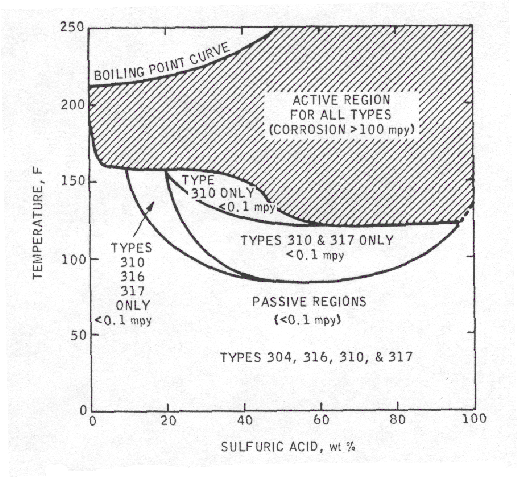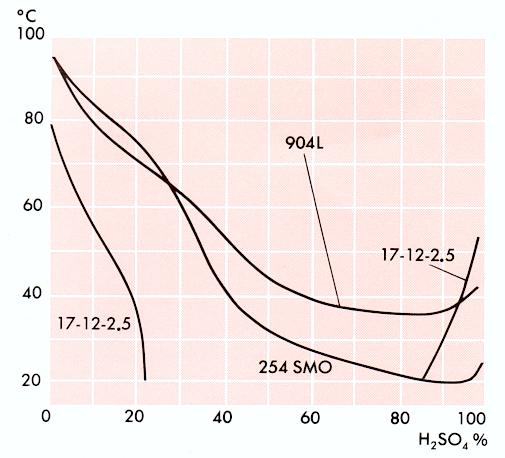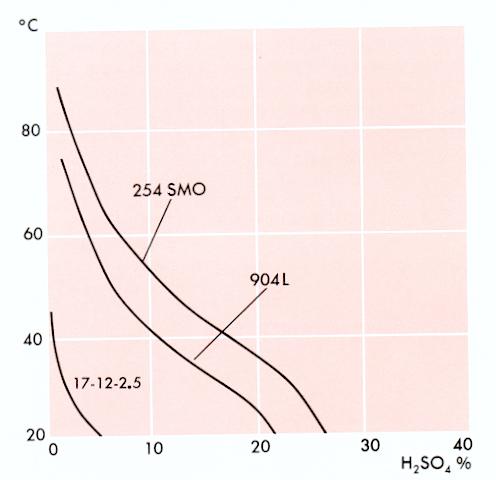Sulfuric acid corrosion resistance of stainless steel
Sulfuric acid corrosion resistance of stainless steel
Ordinary stainless steel is not usually used in equipment contacting sulfuric acid. 18-12m o stainless steel is occasionally used in medium containing very dilute sulfuric acid at room temperature or in dilute sulfuric acid solution containing oxidizing components. Because stainless steel has unstable corrosion resistance in sulfuric acid, it is difficult to obtain reliable data and make corrosion diagram.
In room temperature sulfuric acid, stainless steel has good corrosion resistance, but in general, it is better to use carbon steel than stainless steel. Stainless steel can only be used if the medium requires to prevent iron ion pollution or when about 101% sulfuric acid medium carbon steel cannot be used. Chromium stainless steel, chromium nickel stainless steel and chromium nickel molybdenum stainless steel are similar, which have good corrosion resistance in room temperature concentrated sulfuric acid, and the corrosion rate also increases with the increase of temperature. In concentrated sulfuric acid above 60 ℃, the service life is shorter and should not be used.
The corrosion resistance of 1cr18ni11si4a1ti containing silicon is much better than that of ordinary stainless steel in concentrated sulfuric acid, even at higher temperature. 1cr18ni11si4a1ti steel has better corrosion resistance than other stainless steel in 97% sulfuric acid. Therefore, 1cr18ni11si4a1ti can be used in the equipment used in concentrated sulfuric acid at 60-100 ℃ without expensive nickel molybdenum alloy.
This is the case with the pumps and valves used in the synthetic alcohol equipment in China, and the effect is remarkable.
Stainless steel containing copper and molybdenum, such as ocr18ni18mo2cu2ti and 1cr17mn9ni3mo3cu2n steel, is mainly used in dilute sulfuric acid. This kind of steel can be used in sulfuric acid with temperature less than 40 ℃ and concentration less than 70%. In sulfuric acid with concentration less than 5%, it can also be used when the temperature is up to 80 ℃. The steel is suitable for the manufacture of castings or forgings such as pumps, valves, etc.
SS304
Type 304 stainless steel is the most versatile and one of the most widely applied of the 300 series stainless steels. It has excellent forming and welding characteristics. The carefully controlled analysis of Type 304 enables it to be deep drawn more severely than Types 301 and 302 without intermediate softening. This property has made this grade dominant in the manufacture of drawn stainless steel parts. It is readily brake brake or roll formed into a variety of other parts for application in the industrial, architectural and transportation fields.
Type 304 also has outstanding welding characterisitics. Post-weld annealing is not required to restore the excellent performance of this grade in a wide range of midly corrosive conditions.

SS316
Type 316/316L stainless steel is a molybdenum beraing grade of steel. The presence of molybdenum gves this stainless steel better overall corrosion resistance properties than types 301 and 304 stainless steel. Type 316 gives useful service at room temperature in sulphuric acid of concentrations lower than 15% wt. and greater than 85% wt. It also resist chloride attack and is often used in marine environments.
Type 316L has a maximum carbon content of 0.03% wt. It is used in applications where it is not possible to anneal after welding and where maximum corrosion resistance is required.

SS904L
Avesta Sheffield 254 SMO® (UNS S31254) is an austenitic stainless steel which due to its high molybdenum content possesses very high resistance to pitting and crevice corrosion. The metal was developed for use in halide-containing environments such as seawater. 254 SMO also shows good resistance to uniform corrosion and is superior to conventional stainless steels especially in acids containing halides.
The high levels of molybdenum in particular but also of chromium and nitrogen endow 254 SMO with extremely good resistance to pitting and crevice corrosion. The addition of copper provides improved resistance in certain acids. Futhermore, due to its relatively high nickel content in combination with the high levels of chromium and molybdenum 254 SMO possesses good resistance to stress corrosion cracking.
Even highly alloyed stainless steels have a vary limited applicability in environments which contain halide ions, e.g. chloride, bromide and fluoride solutions. For this reason it has often been necessary to use expensive materials such as nickel based alloys or titanium for these environments. 254 SMO was developed with a view of offering a less expensive alternative.
Due to its high nitrogen content 254 SMO has higher mechanical strength than most other austenitic stainless steels. Like these 254 SMO is characterized by high ductility and impact strength as well as good weldability. The high molybdenum content of 254 SMO can lead to an increased oxidation rate at annealing and as a consequence a rougher surface finish after pickling than standard stainless steels. This has, however, no negative influence on the corrosion resistance of the material.



